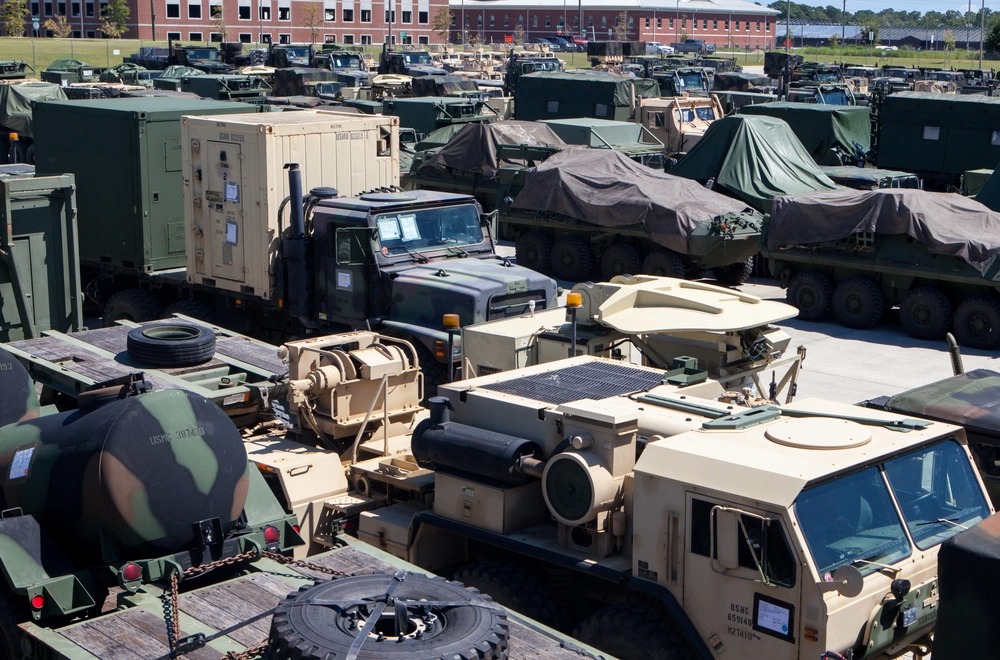
*****
New Marine Corps Logistics Plan Calls for Pre-Positioned Stocks to be Integrated into a Global Positioning Network
ARLINGTON, Va. — The Marine Corps is refining its logistics concepts in conjunction with the commandant’s Force Design 2030 to provide sustainable logistics in a contested environment. The plan includes integrating its pre-positioned stocks into a Global Positioning Network (GPN), the Corps said in a Feb. 23 press teleconference.
The plan — Installations and Logistics 2030 — was released Feb. 23 by Marine Corps Commandant Gen. David H. Berger, who said in the accompanying release that, “[a]ny student of military history understands the critical nature of logistics and sustainment capabilities. We are focusing on diversifying distribution models, resourcing and improving sustainment capabilities, and ensuring the most resilient installations.”
“One broken link in a supply chain can result in an untethered force,” said Lt. Gen. Edward Banta, deputy commandant for Installations and Logistics. “A web mentality assures sustainment of the force and can absorb disruption.”
Logistics Upgrades Needed
The plan directs myriad studies and experiments to re-vamp the logistical systems and make them more forward and resilient, modify force structure tailored the Stand-In Force operating inside an enemy’s engagement zone, and to and able to take advantage of emerging technologies, including unmanned systems, tele-maintenance, 3D printing, and alternative energy sources.
“Stand-in Forces are small, low signature, mobile, relatively simple-to-maintain-and-sustain forces designed to operate across the competition continuum within a contested area,” the release said. “They are the leading edge of a maritime defense-in-depth in order to intentionally disrupt the plans of a potential or actual adversary.”
“We are changing our global posture with a new Global Positioning Network (GPN) that leverages afloat and ashore capability sets for responsiveness,” Banta said. ”The GPN also matures our relationships with partners and allies for access, basing, and overflight. Within the GPN we will be pushing higher echelons of maintenance further forward, as well as leveraging the already existing global presence of commercial industry partners. An example here is the ability of forklift operator to reach over to a Caterpillar dealer in the region, versus having to order a part from back in the Continental United States.”
The new document says that the current logistics concept “relies on deliberate, multi-modal movement of equipment and supplies across a linear logistics and supply chain, requiring large warehousing and trans-shipment nodes to break down, consolidate, and repackage shipments for delivery to the end user. Our supply chains have been developed for efficiency, not effectiveness. One broken link in the supply chain can result in an untethered force.”
The GPN will be designed to be a supply web instead of a supply line.
“Instead of relying on a singular, vulnerable chain, we must build a more resilient supply web that can adapt to temporary broken links or obstructions,” the new document said. “Improving sustainment will demand global logistics solutions that are non-linear and distributed, have a smaller physical footprint at any one site, and limit the vulnerability of forward forces.”
The Marine Corps maintains prepositioned stocks of weapons, equipment, and supplies on Military Sealift Command ships at Diego Garcia and the Marianas, plus a stock at a facility in Norway. The Corps will be integrating its pre-positioned stocks into the GPN.
In response to a question from Seapower Magazine about the pre-positioned stocks, Col, Michael Mulvey, Futures branch head for Logistics Vision and Strategy said, “[We] are looking at an integrated global positioning network now. So that’s, that’s a combination of both afloat and ashore platforms that enables campaigning. So that’s steady state operations that Marines will do from day to day. And by having that forward position [with] the equipment and capabilities inside the first island chain and in the Indo Pacific, we can transition much more efficiently from campaigning to a conflict scenario if we need that.”
“The logistical challenge in front of us is massive. But the risks of not implementing change are clear – the Naval Expeditionary Force becomes unnecessarily vulnerable, particularly while operating in forward and distributed formations,” Berger said in the new document. “Transforming our current installations and logistics related capabilities, capacity, and resiliency to support the future force more effectively, while reducing risk to our units, Marines, Sailors, families, and allies and partners is paramount. The time for action is now.”
Installations and Logistics 2030 can be downloaded from the USMC website.
- Insitu Going Strong at 30, Focusing on Maritime Operations - April 8, 2024
- Navy Awards Boeing Additional Funds for MQ-25 Drones for Testing - April 3, 2024
- Benign 4th Fleet AOR Useful for Unmanned Vehicle Operationalization, Admiral Says - March 27, 2024






